Tehran – In recent months, tensions in the Persian Gulf have once again affected the global spotlight, not through official declarations, but through repeated quiet escalations between the waves and the straits.
A series of maritime incidents, including ship seizures, sabotages and contested operations near the Strait of Hormuz, mark a new stage in the longstanding shadow war between Iran and its regional and international rivals.
Geopolitical chessboard under the waves
The Persian Gulf is more than a strategic waterway. It is a living barometer of regional power shifts. The restructuring of the alliance after the Abraham agreement, coupled with US naval fluctuations and the expansion of Chinese and Russian maritime interests, strengthened the complexity of security architecture in the Persian Gulf. In this changing topography, Iran has reaffirmed its deterrence policy by highlighting control of maritime boundaries and responding to all provocations assertively.
What distinguishes recent maritime conflicts is the evolving use of asymmetric tactics by Iran. The strategic use of herd boating strategies, drone surveillance, and legal justification (such as maritime law and territorial infringement) created layered deterrence. This fusion of legitimate framing and tactical innovation complicates traditional Western responses, particularly in light of the overstretched commitment of the US navy and reducing local political will.
The revival of maritime tensions arrives as the world’s energy routes remain vulnerable. The Ukrainian War has focused on the Black Sea, but the perturbation (escalation or miscalculation) in the Persian Gulf will soon echo across the global oil market. Recent warnings from international maritime organizations and the surge in insurance for ships passing through the Strait of Hormuz reflect this potential uncertainty.
What the West misses
Western tales often make Iran’s maritime movements purely aggressive or unstable. What they don’t capture is the recognition of Tehran’s maritime sovereignty and the deep belief that the Strait of Hormuz is not just an oil conduit, but the forefront of decades of conflict. The lack of regional maritime security frameworks driven by competition and external interference in the Persian Gulf is not dangerously regulating space.
If maritime escalation is avoided, local actors and global forces range from iconic gestures to structured engagement. Multilateral frameworks that include regional naval de-extension agreements and recognition of mutual security concerns must take priority over sanctions and unilateral operations. Only then can the Persian Gulf evolve from a permanent flashpoint into a stable corridor of energy, commerce and cooperation.

